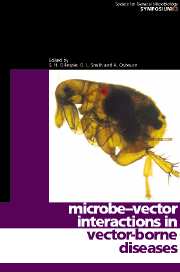Book contents
- Frontmatter
- Contents
- Contributors
- Editors' Preface
- 1 Vector-borne diseases
- 2 Evolution of tick-borne disease systems
- 3 Insect transmission of viruses
- 4 RNA-based immunity in insects
- 5 Specificity of Borrelia–tick vector relationships
- 6 Bunyavirus/mosquito interactions
- 7 How do mosquito vectors live with their viruses?
- 9 Vector competence
- 9 Environmental influences on arbovirus infections and vectors
- 10 Vector immunity
- 11 Transmission of plant viruses by nematodes
- 12 Wolbachia host–symbiont interactions
- 13 Pathogenic strategies of Anaplasma phagocytophilum, a unique bacterium that colonizes neutrophils
- 14 Interactions of Yersinia pestis with its flea vector that lead to the transmission of plague
- 15 Transgenic malaria
- 16 Vaccines targeting vectors
- Index
16 - Vaccines targeting vectors
Published online by Cambridge University Press: 06 July 2010
- Frontmatter
- Contents
- Contributors
- Editors' Preface
- 1 Vector-borne diseases
- 2 Evolution of tick-borne disease systems
- 3 Insect transmission of viruses
- 4 RNA-based immunity in insects
- 5 Specificity of Borrelia–tick vector relationships
- 6 Bunyavirus/mosquito interactions
- 7 How do mosquito vectors live with their viruses?
- 9 Vector competence
- 9 Environmental influences on arbovirus infections and vectors
- 10 Vector immunity
- 11 Transmission of plant viruses by nematodes
- 12 Wolbachia host–symbiont interactions
- 13 Pathogenic strategies of Anaplasma phagocytophilum, a unique bacterium that colonizes neutrophils
- 14 Interactions of Yersinia pestis with its flea vector that lead to the transmission of plague
- 15 Transgenic malaria
- 16 Vaccines targeting vectors
- Index
Summary
INTRODUCTION
It has been known for a long time that arthropods requiring blood meals induce pronounced immune responses in the host on which they feed (Trager, 1939). These, together with the wide range of haemostatic mechanisms that are employed by the host to avoid blood loss, present a formidable barrier to the arthropod' essential need for regular blood meals in order to moult or produce eggs.
The immune responses first recognized were in those vector–host interactions where the arthropod remains attached to its host for a long period – days or often weeks. This is true of many ticks. The much cited work of William Trager (1939) is recognized as one of the seminal studies on anti-tick resistance and, during the past 60 years, a great deal has been learned about the numerous underlying mechanisms.
It is not surprising that such a lengthy and intimate association leads to cellular and humoral responses to vector antigens. However, it is now equally clear that such responses can also develop to haematophagous arthropods that feed rapidly and then leave the host. Notable here are insects of medical importance such as mosquitoes, sandflies and black flies.
Extensive studies have shown that, in both the slow-feeding (tick) and rapid-feeding (insect) arthropods, there is an array of immunomodulatory factors to counter the induction of immune responses, to deflect the immunity away from mechanisms that are harmful to the arthropod, or to lessen the effect of these if they do occur.
- Type
- Chapter
- Information
- Microbe-vector Interactions in Vector-borne Diseases , pp. 363 - 378Publisher: Cambridge University PressPrint publication year: 2004
- 1
- Cited by



